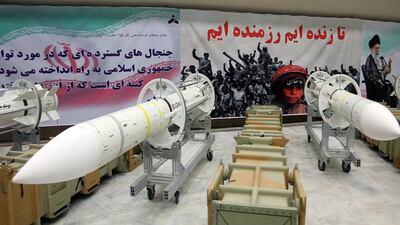The United States for the first time imposed sanctions on Iran's civilian space agency and two research organisations on Tuesday, accusing them of developing ballistic missiles.
It follows an explosion last week at the Imam Khomeini Space Centre. It was the third rocket mishap at the centre and the US claims that it is a sign of missile work, which Iran denies.
"The United States will not allow Iran to use its space launch programme as cover to advance its ballistic missile programmes," US Secretary of State Mike Pompeo said at the time.
What is Iran’s ballistic missile programme?
Iran has been developing ballistic missiles since the 1980s war with Iraq. They are based on Russian, North Korean, and Chinese technology and weapons systems and Tehran has one of the largest inventories of ballistic missiles in the Middle East. According to the 2016 Worldwide Threat Assessment, Iran’s ballistic missiles are inherently capable of delivering weapons of mass destruction.
Why is the ballistic missile programme a problem?
Ballistic missiles are a critical component of nuclear weapons, as they can be fitted with enriched material. Although it is still debated whether the testing of ballistic missiles contravenes the 2015 Joint Nuclear Plan of Action agreed with world powers, they could be used to carry a nuclear warhead and as a result are subject to US and United Nations sanctions.
In 2016, Iran’s missile tests were found to be in defiance of the UN Security Council resolution that endorsed the nuclear deal, and was said to be “not consistent with the constructive spirit” of it.
A report released at the end of last year by the UN included evidence that Iranian missiles were being used by Yemen’s Houthi rebels to target Saudi Arabia. At around the same time in a letter to UN Secretary-General António Guterres, the United Kingdom, France, and Germany described ballistic missiles fired by Iran into Syria in October as “inherently capable of [the] delivery [of] nuclear weapons.”
Last month, Revolutionary Guard commander Major General Hossein Salami said Iran has test-fired a new missile.
"Our country is always the arena for testing a variety of defence and strategic systems and these are
non-stop movements towards the growth of our deterrent power," Salami said.
Critics fear they will be use to target Israel and other regional enemies.
What has been done to limit the programme?
In 2006, the UN Security Council banned the supply of materials and technology to Iran that might aid nuclear activities or the development of nuclear weapon delivery systems. It also asked countries to freeze the assets of certain companies and individuals related to the programme. The sanctions have since been increased a number of times.
The European Union and US have gone even further, targeting not only individuals and firms involved, but also banks and transport companies linked to procurement and financing the programme.
Iran's parliament in 2017 approved more than US$500 million in funding for the country's missile programme and the foreign operations of its elite Revolutionary Guards in response to US sanctions.

